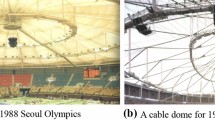Abstract
Construction errors are inevitable in real cable-strut tensile structures. Nevertheless, the relevant work, especially the monitoring scheme design work, to control the construction errors is lacking. At present, the monitoring schemes always lay out the monitored members in the places with great internal force or great deformation, do not consider the method to control the construction errors and do not explain the method to lay out the monitored members in fundamental theory. To address this situation, the element length error, which is an important construction error affecting the bearing performance, is considered as the factor variable and the fundamental equation of pre-stress deviation and element length error is derived firstly. Next the methods to express the pre-stress deviation, which are only derived from the active cable length errors or from both the active cable and passive cable length errors, are discussed. After that, based on the condition that the errors can be solved and compensated, the least number of monitored members is determined. Moreover, those members sensitive to cable length deviation of active cables are selected as monitored members. In order to evaluate the effect level caused by passive cable length deviation, two evaluation parameters Δ and ρ are further discussed. Finally, one cable-strut tensile structure example is employed to verify the proposed method and the results of the example studies indicate that the least necessary number of monitored members can be achieved for the accurate solution and compensation of active cable length deviations. Different members have different sensitivities to the change of the length in active cables and those members with great sensitivities can be chosen in prior as monitored members. The evaluation parameters Δ and ρ can be used to analyze the source of errors and to evaluate the error effect level caused by the passive cable length deviation.
Similar content being viewed by others
References
Bueno, A., Torres, B., Barrera, D., Calder_on, P., and Sales, S. (2010). “Monitoring of a steel incrementally launched bridge construction with strain and temperature FBGs sensors.” in Int. Soc. Opt. Photonics, pp. 772620–772620–8, DOI: 10.1117/12.854575.
Chen, L. M., Deng, H., Cui, Y. H., and Zhou, Y. Y. (2016b). “Optimal construction scheme of the cable-strut tensile structure for controlling construction errors.” Open Civil Engineering Journal, Vol. 10, pp. 751–758, DOI: 10.2174/1874149501610010751.
Chen, L. M., Deng, H., Cui, Y. H., Dong, S. L., and Zhou, Y. Y. (2016a). “Theoretical analysis and experimental study on sensitivity of element-length error in cable-strut tensile structures.” Advances in Structural Engineering, Vol. 19, No. 9, pp. 1463–1471, DOI: 10.1177/1369433216643245.
Gao, B. Q., Xie, Z. L., Liang, J., and Peng, W. X. (2005). “Sensitivity analysis of cables to Geiger dome structure.” Journal of Zhejiang University Engineering Science, Vol. 39, No. 11, pp. 1685–1689.
Geiger, D. H. (1986). “The design and construction of two cable domes for the Korean Olympics.” Shells, Memberanes and Space Frames, Proc. IASS Symp., Osaka, Elsevier Scicence Publishers B. V., pp. 265–272.
Hu, D. T., Guo, Y. X., Chen, X. F., and Zhang, C. R. (2017). “Cable force health monitoring of tongwamen bridge based on fiber bragg Grating.” Applied Sciences-baseL, Vol. 7, No. 4, pp. 384, DOI: 10.3390/app7040384.
Jiang, S. and Hua, X. (2013). “Construction site environment temperature monitoring system based on zigbee and virtual instrument.” J. Netw. Vol. 8, No. 4, pp. 963–970, DOI: 10.4304/jnw.8.4.963-970.
Levy, M. P. (1994). “The Georgia dome and beyond achieving light weight-long span structures.” Proc. IASS-ASCE Int. Symp. Atlanta, USA, pp. 560–562.
Liu, H. B., Chen, Z. H., and Niu, B. (2012). “Numerical simulation and in-situ monitoring of pre-stressing construction of suspen-dome structures.” Journal of Building Structures, Vol. 33, No. 12, pp. 79–84, 129.
Lu, W., Cui, Y., Teng, J., and Lu, F. Z. (2017). “Structural-performance tracking to multitype members of shenzhen vanke center in construction phase.” Journal of Aerospace Engineering, Vol. 30, No. 2, DOI: 10.1061/(ASCE)AS.1943-5525.0000702.
Masato, Abe and Yozo, Fujino (2017). “Monitoring of long-span bridges in Japan.” Proceedings of the Institution of Civil Engineering-Civil Engineering, Vol. 170, No. 3, pp. 133–144, DOI: 10.1680/jcien.16.00002.
Ni, Y. Q., Li, B., Lam, K. H., Zhu, D. P., Wang, Y., Lynch, J. P., and Law, K. H. (2011). “In-construction vibration monitoring of a super-tall structure using a long-range wireless sensing system.” Smart Structures and Systems, Vol. 7, No. 2, pp. 83–102, DOI: 10.12989/sss.2011.7.2.083.
Pellegrino, S. (1993). “Structural computations with the singular value decomposition of the equilibrium matrix.” International Journal of Solids and Structures, Vol. 30, No. 21, pp. 3025–3035, DOI: 10.1016/0020-7683(93)90210-X.
Pellegrino, S. and Calladine, C. R. (1986). “Matrix analysis of statically and kinematically indeterminate frameworks.” International Journal of Solids and Structures, Vol. 22, No. 4, pp. 409–428.
Shahawy, M. A. and Arockiasamy, M. (1996). “Field instrumentation to study the time-dependent behavior in sunshine skyway bridge.” I, J. Bridge. Eng., Vol. 1, No. 2, pp. 76–86, DOI: 10.1061/(ASCE)1084-0702(1996)1:2(76).
Teng, J., Xiao, Y. Q., Liu, C. Y., Yu, H. T., and Liu, H. T. (2012). “Practical structural health monitoring systems in large space structures.” 13th ASCE Aerospace Div. Conf. Engineering, Science, Construction, and Operations in Challenging Environments, pp. 1177–1186.
Wang, X. L., Li, Y., and Yang, W. W. (2013). “Health monitoring and simulation analysis of steel roof structure of Xining Gymnasium under construction.” Journal of Gansu Sciences, Vol. 25, No. 1, pp. 104–106.
Yuan, X. F. and Dong, S. L. (2002). “Nonlinear analysis and optimum design of cable domes.” Engineering Structures, Vol. 24, No. 7, pp. 965–977, DOI: 10.1016/S0141-0296(02)00017-2.
Zhou, T. Q. and Hua, Y. (2008). “Displacement monitoring analysis of a stadium reticulated shell structure during construction process using optical apparatus.” 7th Asian Conf. Exp. Mech., pp. 73750L–73750L–7, DOI: 10.1117/12.839025.
Author information
Authors and Affiliations
Corresponding author
Rights and permissions
About this article
Cite this article
Chen, Lm., Gao, Wf., Hu, D. et al. Determination of a Monitoring Scheme for Controlling Construction Errors of a Cable-strut Tensile Structure. KSCE J Civ Eng 22, 4030–4037 (2018). https://doi.org/10.1007/s12205-018-1583-4
Received:
Revised:
Accepted:
Published:
Issue Date:
DOI: https://doi.org/10.1007/s12205-018-1583-4




